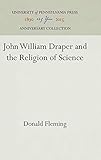John William Draper and the Religion of Science / Donald Fleming.
Material type: TextSeries: Anniversary CollectionPublisher: Philadelphia : University of Pennsylvania Press, [2016]Copyright date: ©1950Edition: Reprint 2016Description: 1 online resource (216 p.) : 1 illusContent type:
TextSeries: Anniversary CollectionPublisher: Philadelphia : University of Pennsylvania Press, [2016]Copyright date: ©1950Edition: Reprint 2016Description: 1 online resource (216 p.) : 1 illusContent type: - 9781512801699
- 9781512801705
- 925
- Q143.D77
- online - DeGruyter
- Issued also in print.
| Item type | Current library | Call number | URL | Status | Notes | Barcode | |
|---|---|---|---|---|---|---|---|
 eBook
eBook
|
Biblioteca "Angelicum" Pont. Univ. S.Tommaso d'Aquino Nuvola online | online - DeGruyter (Browse shelf(Opens below)) | Online access | Not for loan (Accesso limitato) | Accesso per gli utenti autorizzati / Access for authorized users | (dgr)9781512801705 |
Frontmatter -- PREFACE -- CONTENTS -- Chapter I. EUROPE -- Chapter II. VIRGINIA -- Chapter III. “THE BRIGHT SPECK IN EACH EYE” -- Chapter IV. “THE AMERICAN DAVY” -- Chapter V. THE NET OF CREATION -- Chapter VI. THE TURNING POINT -- Chapter VII. ROCK-PIGEONS AND APES -- Chapter VIII. THE WEB OF HISTORY -- Chapter IX. THE REIGN OF REASON -- Chapter X. WAR HISTORIAN -- Chapter XI. SCIENCE AND RELIGION -- Chapter XII. TWILIGHT OF A PATRIARCH -- NOTES -- BIBLIOGRAPHICAL ESSAY -- BIBLIOGRAPHICAL LIST -- INDEX
restricted access online access with authorization star
http://purl.org/coar/access_right/c_16ec
A whole chapter of nineteenth-century history is condensed in the phrase "the conflict between religion and science," with our Mother Eve and the proto-Ape jostling for places at the head of the family tree. An outstanding figure in the center of this intellectual conflict was John William Draper, author of History of the Intellectual Development of Modern Europe and The Conflict Between Religion and Science, which played an important part in intellectual debates for many years.Draper helped break new ground for an age of science, and brought to the level of laymen some of the issues with which they must grapple in the future. However, he had the gift of the great popularizer for seeming to leaven the loaf of tradition, instead of throwing it away, and succeeded in lending to new ideas the appearance of old ones. His work is an excellent case history of the way in which innovations are knit up into continuity with tradition and revolutions in thought are made palatable.
Issued also in print.
Mode of access: Internet via World Wide Web.
In English.
Description based on online resource; title from PDF title page (publisher's Web site, viewed 26. Apr 2024)


